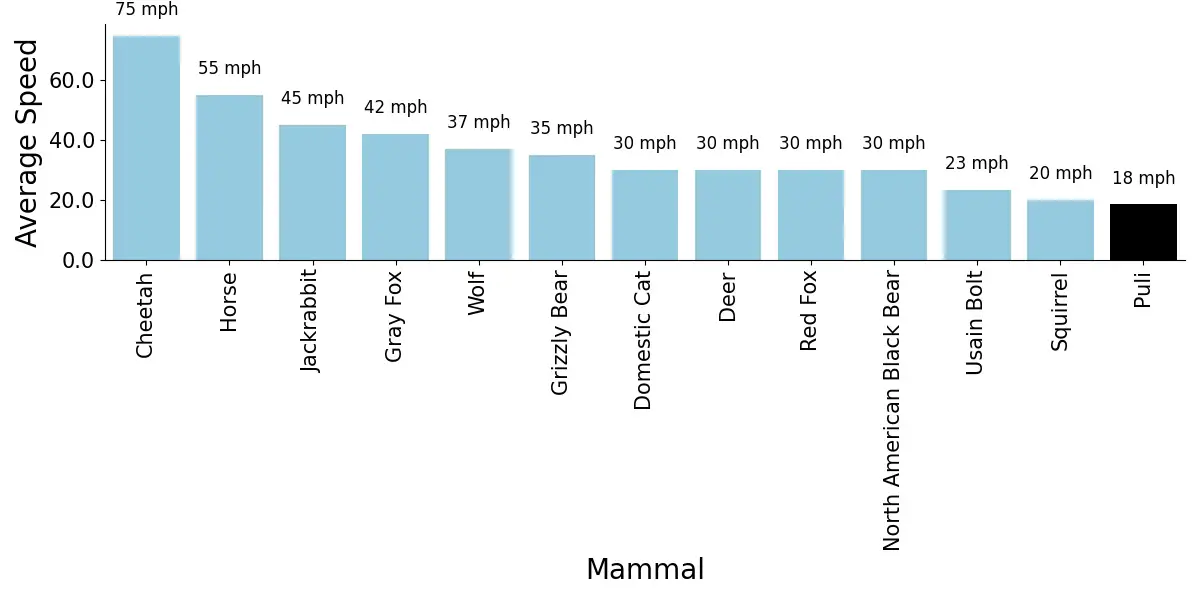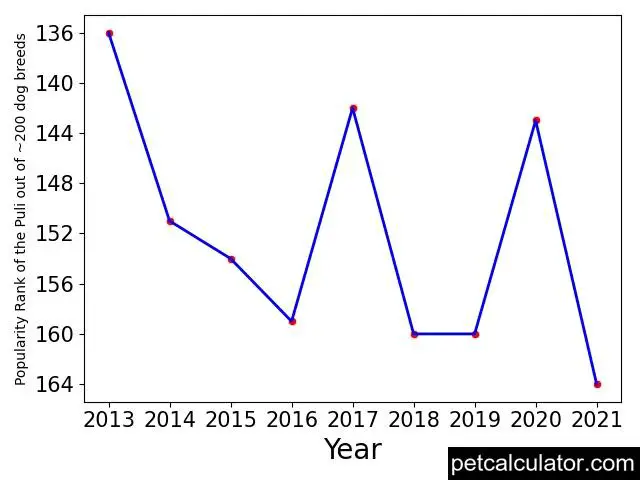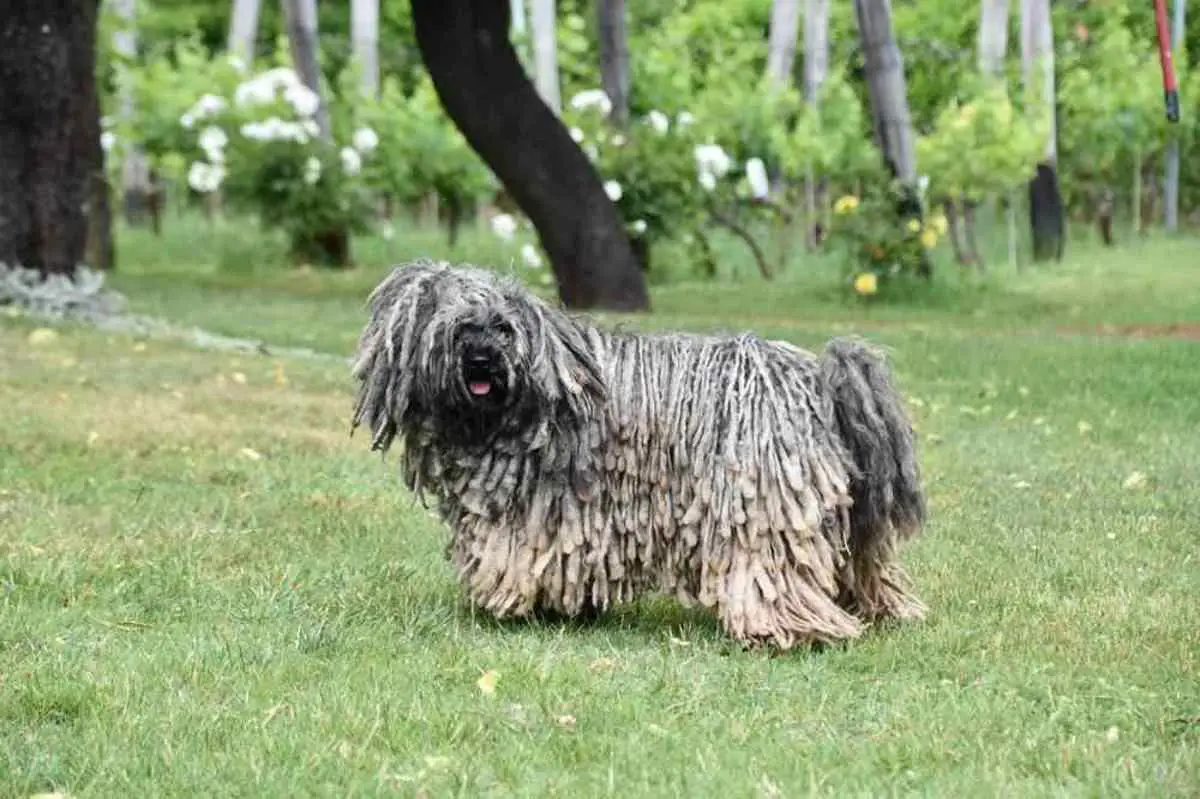Quick Links: Table of Contents
- Puli Breed Overview
- History of the Puli Breed. Where Pulis came from
- What the Puli Looks Like
- How Much is the Puli Puppy?
- Best Puli Breeders
- What Colors do Pulis Have?
- Puli Litter Size
- How Fast Pulis Can Run
- How Intelligent are Pulis?
- How Popular are Pulis with New Dog Owners?
- Health Problems in Pulis and How to Prevent Them
- Dog Breeds That Are Similar to Pulis
- Other Things to Know About Pulis
Puli Breed Overview
The Puli is a medium-sized dog.
The adult Puli stands 16 to 17 inches tall at the shoulder.
The Puli belongs to the Herding Dogs group.
Dogs in the Herding Dogs group, like the Puli, were bred for moving livestock, including sheep, cattle, and even reindeer.
Herding dogs work closely with their human shepherds, and their natural intelligence and responsiveness make them highly trainable.
Herding dogs have high levels of energy, which needs to be channeled properly to prevent destructive behavior.
Herding breeds are protective of their people and property and make excellent watchdogs. Their intelligence, agility, and activity level make them well suited to dog sports.
The fact that Pulis belong to the Herding Dogs group is one of the reasons why Pulis have the personality and temperament that they have.
The temperament of the Puli is generally described as:
- Agile
- Energetic
- Faithful
- Intelligent
- Loyal
- Obedient
History of the Puli Breed. Where Pulis came from
The Puli is a medium-sized Hungarian herding and livestock guarding dog breed.
The Puli is Puli dog well known for its long, corded coat.
The Puli`s coat is similar to dreadlocks or a mop, and is often gray, black, or white in color.
The Pulik are the most popular Puli dogs.
Pulis were brought to Europe by the Magyars more than 1,000 years ago.
Hungary is the country of origin for the Puli.
Some believe that the Puli may have been used as a hunting dog in ancient times.
Today, the Puli is used as a sheepdog and as a companion dog.
The Puli is an intelligent breed that is easy to train.
They are also very active and need plenty of exercise.
.
What the Puli Looks Like
The Puli is a small-medium breed of Hungarian herding and livestock guarding dog known for its long, corded coat.
The tight curls of the coat form Matted dreadlocks all over the body, making Pulik.
corded similar to the coats of Pulik.
Pumi and Komondor breeds.
The Puli is a solid colored dog that comes in black, white, gray, or cream.
Pulik have a long head with erect ears and almond shaped eyes.
They have a thick double coat that is wavy or curled.
The outer coat is coarse and wiry while the undercoat is soft and dense.
Pulik are considered hypoallergenic because they do not shed their hair.
Instead, Pulik blow their coat twice a year which means they lose their dead hair all at once.
This process can last for weeks and during this time Pulik will need to be brushed daily to prevent mats from forming in their fur.
They are lively, agile dogs with a lot of energy.
Pulik are independent thinkers and can be stubborn so they need consistent training and socialization from an early age.
Pulik are loyal, protective dogs that make great family pets.
.
How Much is the Puli Puppy?

The average price of a Puli puppy is $1880. The price of a Puli puppy ranges from $1562 to $2188.
A lot of factors determine the price of the Puli. These factors include what health records the Puli puppy has, the lineage of the Puli puppy, the US state the breeder is located in, etc.
To estimate how much you can expect to pay for a puppy Puli based on the many factors that determine the price of the Puli puppy, check out our calculator that lets you estimate how much you should expect to pay for the Puli puppy based on what you want in the puppy.
When looking to buy a puppy, look at buying a puppy only from well-established breeders that breed puppies primarily for the love of the Puli breed, and secondarily for profit. Do not buy a puppy from a puppy mill. Puppy mills mass-produce puppies in bad living conditions for maximum profit.
You may also consider adopting instead of buying a puppy. Adoption costs are very low compared to the price of a puppy.
Best Puli Breeders

We have researched reputable Puli breeders that you can buy a puppy.
Go to this page for our complete list of reputable Puli breeders in various states in the United States.
On this page, you will see how much these breeders sell their puppies for, and how many puppies they have available.
A few of these breeders are listed below.
Sky Blue Puli
Puppy Price: Check with breeder
Angyal Haz Pulik
Puppy Price: Check with breeder
Sunday Pulik
Puppy Price: Check with breeder
Noe Barkaja
Puppy Price: Check with breeder
The Puli People
Puppy Price: $2200.00
What Colors do Pulis Have?
Pulis come in the following beautiful primary colors:
Pulis come in the following lovely secondary colors in addition to their primary colors:
Puli Litter Size
Researchers from the Norwegian School of Veterinary Science did a study where they counted the numbers of puppies in 2 different Puli birth litters.
From this study, the researchers found that the average number of puppies that Pulis can have is 4 puppies. Also, the Puli can have as few as 3 puppies per litter and as many as 5 puppies per litter.
The number of puppies that the Puli will have depends on factors such as the age of the Puli, the method of pregnancy, etc.
Click here to see our calculator for predicting how many puppies your Puli will have and how the litter size of the Puli compares to the litter size of other dog breeds.
How Fast Pulis Can Run

How fast a dog breed can run is a good measure of how athletic the dog breed is.
The American Kennel Club (AKC) regularly conducts dog running competitions. The AKC records the running speed of competing dogs in these competitions. These competitions are open to all dog breeds.
Based on our analysis of the speeds of 15 different Pulis, the average speed of the Puli is 18.5 mph (29.8 kmph).
The fastest speed on AKC record that the Puli ran in a race is 23.78 mph (38.3 kmph) and the minimum speed on record in a race for a Puli is 10.85 mph (17.5 kmph).
Click here to see how the speed of the Puli compares to the speed of other dogs and other mammals such as cats, horses, humans, etc.

How Intelligent are Pulis?
| Puli | |
|---|---|
| Intelligence Rank | 27 out of 130 dog breeds |
| Trainability | Tend To Learn New Commands After 15 To 25 Repetitions |
According to Prof. Stanley Coren, a Canadian psychology professor/dog trainer, the total intelligence that a dog demonstrates is the addition of three types of intelligence. These intelligence types are:
- Instinctive Intelligence: This is the natural intelligence that comes from instinct. For example, dog breeds that have been historically bred to be guard dogs will have a high `guarding` intelligence compared to dogs that were not bred for guarding.
- Adaptive Intelligence (learning and problem-solving ability): This indicates what a dog can learn to do for himself or herself. Adaptive intelligence is specific to each dog, and not breed specific. You can improve your dog`s adaptive intelligence by investing time to train your dog.
- Working/Obedience Intelligence: This type of intelligence is breed-specific. Certain dog breeds tend to have higher working/obedience intelligence than some other breeds. This intelligence is the closest to what we might call school-learning ability and it is based upon what the dog can learn to do when instructed by humans. This type of intelligence can be measured for each dog breed and compared to that of other dog breeds.
Professor Stanley Coren measured and ranked the working intelligence of about 130 different dog breeds.
Prof. Coren found that the Puli has an obedience intelligence rank of 27 out of 130 dog breeds. Thus, Prof. Coren put Pulis in the `Above Average Working Dogs` category.
This means that Pulis tend to learn new commands after 15 to 25 repetitions.
However, we should mention that a dog should not be judged based on its intelligence alone. There are other important factors you need to consider when deciding on which dog breed to get. These other factors include sociability, adorability, and compatibility of the dog breed with your lifestyle.
See the intelligence ranking of some other dog breeds below:
| Breed | Intelligence Rank |
|---|---|
| Border Collie | 1 |
| Shetland Sheepdog | 6 |
| Papillon | 8 |
| Collie | 16 |
| German Shorthaired Pointer | 17 |
| Brittany | 19 |
| Cocker Spaniel | 20 |
| Vizsla | 25 |
| Airedale Terrier | 29 |
| Norwich Terrier | 38 |
| Dalmatian | 39 |
| Boxer | 48 |
| Dachshund | 49 |
| Alaskan Malamute | 50 |
| French Bulldog | 58 |
| Chinese Crested | 61 |
| Old English Sheepdog | 63 |
| Lhasa Apso | 68 |
| Pekingese | 73 |
| Afghan Hound | 79 |
How Popular are Pulis with New Dog Owners?
Every year, the American Kennel Club (AKC) publishes information on how popular a dog breed is in that particular year. The AKC gets the popularity information of a breed from how many dogs of that breed the owners register with the AKC every year. The AKC collects this data for about 200 dog breeds.
The graph below shows the popularity trend of the Puli.
The popularity of the Puli averaged over the years is Number 152 out of about 200 dog breeds.

Do not get a dog breed just because it is a popular dog breed. And do not reject a dog breed just because it is an unpopular breed.
Health Problems in Pulis and How to Prevent Them
Every dog breed has its own set of health problems that it tends to develop. There is nothing like a perfect dog breed.
The Puli is prone to certain genetic health conditions. The Orthopedic Foundation for Animals (OFA) is an organization that keeps track of genetic health problems in dog breeds.
From the extensive records that the OFA keeps, the OFA knows what health problems each dog breed is naturally prone to develop.
Hence, the OFA recommends which health screening breeders should perform on a dog breed to make sure that the breeders won`t breed `defective` dog parents that can pass down defective genes to their puppy offspring.
If you want a Puli puppy that will grow up to be healthy, make sure that your Puli breeder screens your puppy or your puppy`s parents for the health problems that the OFA recommends for your puppy`s breed. This will increase the chances that your puppy is free from genetic defects.
The following are the health tests that Orthopedic Foundation for Animals (OFA) recommends that breeders should screen Pulis for:
- Cardiac Evaluation
- Congenital Deafness
- Degenerative Myelopathy
- Elbow Dysplasia
- Eye Examination
- Hip Dysplasia
- Patellar Luxation
You can find out more about OFA`s recommended tests for Pulis here.
Dog Breeds That Are Similar to Pulis
If you have not made up your mind on which dog breed to get, you may also want to consider some other dogs similar to the Puli.
We crunched the numbers and found that the following dog breeds that have similar behavior and temperament as the Puli:
- Briard (77 percent match with Puli). Learn more about the Briard here.
- Welsh Terrier (75 percent match with Puli). Learn more about the Welsh Terrier here.
- Scottish Terrier (79 percent match with Puli). Learn more about the Scottish Terrier here.
Other Things to Know About Pulis
Here are some of the very important characteristics of the Puli that you need to know about the Puli breed:
